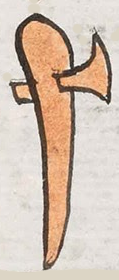Tepoztitlan (Mdz40r)
This simplex glyph for the place name Tepoztitlan shows an upright hatchet with a probable wooden handle and an embedded copper (tepoztli) blade. The wood and the blade are painted the same terracotta color. The wooden handle is thicker at the site of the blade and tapers down to the part that would be hend in the hand. The top of it is rounded. The blade protrudes out the back of the handle, coming to a point. The useable part of the blade is curved. The locative suffix is not shown visibly.
Stephanie Wood
Neither the ti ligature, or the tlan locative, are shown visually. Often the -titlan locative suffix is shown with a full set of teeth, in the shape of a mouth, as Gordon Whittaker has pointed out in Deciphering Aztec Hieroglyphs (2021), 102.
Stephanie Wood
tepoztitlā. pu(sup>o
Tepoztitlan, pueblo
Stephanie Wood
c. 1541, or by 1553 at the latest
Stephanie Wood
nombres de lugares

tepoz(tli), metal or a metal tool, https://nahuatl.wired-humanities.org/content/tepoztli
-ti- (ligature), https://nahuatl.wired-humanities.org/content/ti
-tlan (locative suffix), https://nahuatl.wired-humanities.org/content/tlan
Codex Mendoza, folio 40 recto, https://digital.bodleian.ox.ac.uk/objects/2fea788e-2aa2-4f08-b6d9-648c00..., image 90 of 188.
The Bodleian Libraries, University of Oxford, hold the original manuscript, the MS. Arch. Selden. A. 1. This image is published here under the UK Creative Commons, “Attribution-NonCommercial-ShareAlike 3.0 License” (CC-BY-NC-SA 3.0).

